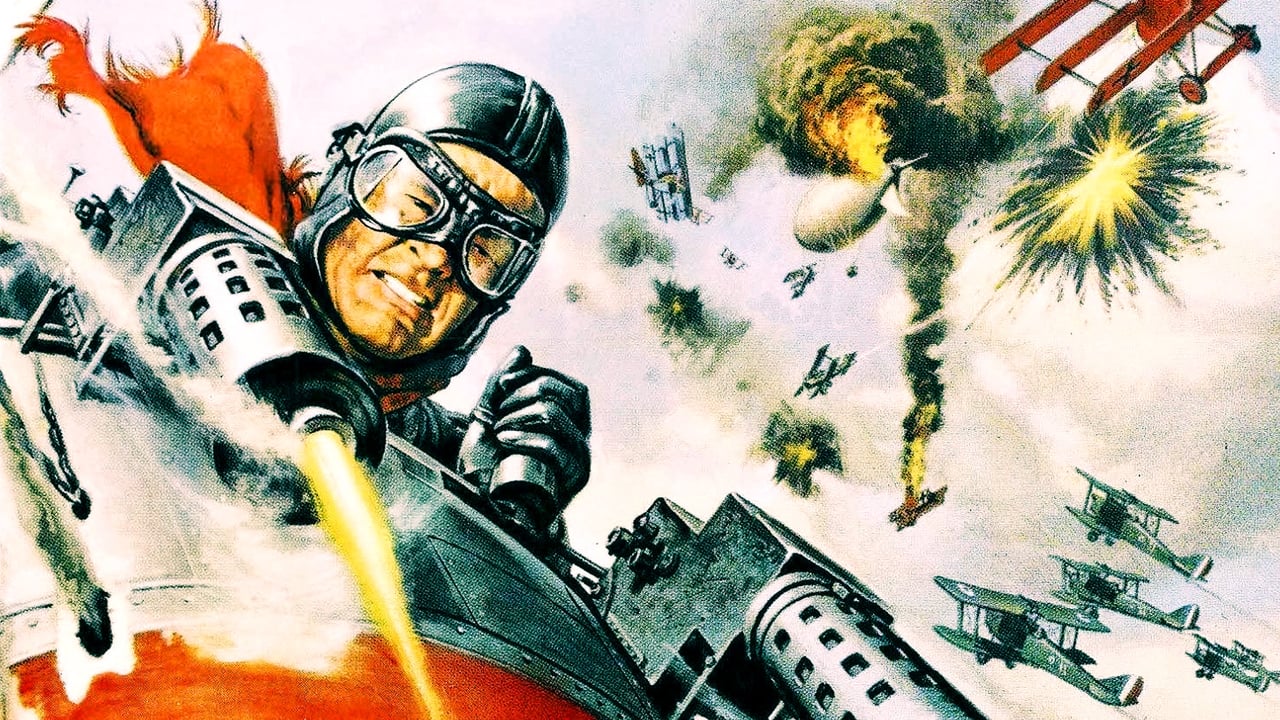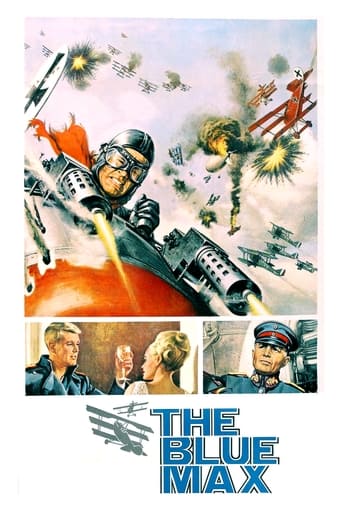

It isn't all that great, actually. Really cheesy and very predicable of how certain scenes are gonna turn play out. However, I guess that's the charm of it all, because I would consider this one of my guilty pleasures.
... View MoreThere is just so much movie here. For some it may be too much. But in the same secretly sarcastic way most telemarketers say the phrase, the title of this one is particularly apt.
... View MoreOne of the best movies of the year! Incredible from the beginning to the end.
... View MoreEach character in this movie — down to the smallest one — is an individual rather than a type, prone to spontaneous changes of mood and sometimes amusing outbursts of pettiness or ill humor.
... View MoreLong before "Waltz of the Toreadors", I had always regarded John Guillermin as a major film-making talent. After a series of second features distinguished mainly by his enthusiasm for unpredictable camera angles, Guillermin was given his head by John Grierson on the Group 3 comedy, "Miss Robin Hood", with a startlingly undisciplined result. His undeniable vigor and inventiveness were then seen to best advantage in the children's film, "Adventure in the Hopfields", and to a lesser extent in "Town on Trial". In 1960, two years before "Waltz of the Toreadors", he directed another Peter Sellers' vehicle, "Never Let Go", which had the distinction of being banned in Australia. With "The Blue Max:, Guillermin may now truly be said to have come of age. Not only is the budget of "The Blue Max" greater than all his previous films combined, but he has managed to sustain his inventiveness right throughout the entire film. Indeed, each scene is more inventive than the last, and the film progresses to a really stunning climax, one of the finest exercises of sheer film-craft I have seen for years.Of course, the director has been greatly helped by his brilliant cinematographer, Douglas Slocombe, who has achieved some wonderful effects in lighting and color. Just one example of the sheer expertise behind the film is the way Slocombe's camera-work blends so perfectly with the aerial shots photographed by Skeets Kelly. If we had not been told, it would be impossible to separate the work of one man from the other. This, of course, is how it should be, but it is not often the case. Notice how poorly the photography blends together in "Red Line 7,000", for instance.Also, no doubt of great assistance to the director, was his talented cast. James Mason gives a superb performance as the conniving Count — one of the most magnetic portrayals he has drawn since Rommel of The Desert Fox. Peppard and Ursula Andress are excellent, and the German actors, Jeremy Kemp and Karl Michael Vogler, turn in such arresting performances they will almost assuredly find themselves in great demand for other roles in English-speaking films. Anton Diffring has for some time been a top star in Britain, where he has specialized in horror films such as "Circus of Horrors", and "The Man Who Could Cheat Death".Full credit for the choice and combination of such a wonderful team both behind and in front of the camera belongs to Elmo Williams, the brilliant former editor (he won an Academy Award for "High Noon") and lately second unit director, "The Vikings", "The Longest Day". For a while there, Williams was in charge of all 20th Century-Fox's European productions.
... View MoreTitled after a World War I German medal for air force pilots with twenty confirmed kills, the plot here follows an ambitious soldier dead set on earning one such medal. As the soldier, George Peppard is well cast with the "satisfaction of knowing you have served the Fatherland" never enough for him, instead yearning for something solid to prove his worth. With lots of impressive stunts, the film shies a bit over Peppard's background and the factors that may have contributed to him being such an emotionless killing machine, however, with his scorned-upon working class background, it is easy to surmise that the German culture of achievement is the main contributing factor. Things get even more complex as Peppard is celebrated by the army as a "hero for the people" due to his working class background and despite the fact that he is hated by his peers for his callousness, never upset when others die. Whether the film really needed to be two and half hours long is debatable; there is an entire subplot with Ursulla Andress that could have been cut. It is quite an immersive experience though despite the odd lull. The film is gloriously photographed with several remarkable crane shots and camera-work from Douglas Slocombe that almost never sits still. The aerial scenes are impressive too and it is easy to see why the film won a BAFTA award in its day for its detailed sets.
... View MoreWorld War I set the template for the bloody 20th century. The Great War, as it was known until World War II, created thousands of heroes. It consumed millions of lives, broke millions of hearts, and damaged millions of psyches. It revealed the murderous implications of technology (much to the shock of Victorians who believed that science and technology represented pure and undiluted progress). It exposed the mendacity of governments, financiers, and elites, thereby destroying the naive trust of the 19th century, when governments and elites were actually believed. ("The last one of all," said the French of this war. "The war to end war" said President Wilson. Mm-hmm.)The Great War has gotten a fair bit of filmic attention, although not as much as it deserves, and not nearly as much as WW II. For me, the movies of WW I that stand out, that are worthy of four stars, are "Lawrence of Arabia," "Paths of Glory," "The Grand Illusion," "A Very Long Engagement," "King & Country," and "La Grande Guerra." I give a solid three stars to "Gallipoli," "The White Ribbon," "Wings," and several others including "The Blue Max."The air war of World War I was epic and highly photogenic. The aerial scenes in "The Blue Max" are excellent and generously long.Most of the acting is very fine. I would especially mention Karl Michael Vogler as the squadron leader; he's entirely convincing. Vogler was a major presence in German film for many years; he appeared only occasionally in Hollywood productions but was always good--for example, his work as Rommel in "Patton," where his weary walk and subdued ferocity perfectly capture the ailing field marshal circa 1943-44.A character actor named Harry Towb plays Vogler's aide-de-camp. He's very strong in the role. I looked him up. He too is in "Patton"--he's the cook who gets chewed out by the general: "Where's your helmet?" demands Patton. "HELMET? General, sir, I'm a COOK!" "You're a soldier. Twenty dollar fine." (That, by the way, is a week's pay.) Stanley Kubrick, who had a gift for finding excellent understated actors, liked Towb's work and cast him as the innkeeper in "Barry Lyndon."George Peppard is OK here. I'm not a Peppard fan--the stiffness and utter lack of depth get to me after a while--but he works hard to portray a guy with a major chip on his shoulder (maybe Peppard's real-life chip helped). One wonders what a good actor might have done with this meaty role. (Michael Caine comes to mind in this regard; also Robert Redford, Oliver Reed, and Warren Beatty.)This film was nearly the last gasp for Peppard's dreams of becoming a superstar. He had been groomed for the spotlight for years ("How the West Was Won," etc.) but it never quite worked out. A year after this film came out, he got second billing to Rock Hudson in the pretty bad "Tobruk," and a year after that starred with Mary Tyler Moore in "What's So Bad About Feeling Good?" which was seen by exactly four people. Peppard's next stop, basically, was TV, where he kept body and soul together for years (despite getting fired from "Dynasty" for being a jerk; John Forsythe got the gig and perhaps wept tears of joy).Ursula Andress is spectacular here. She is at her luscious best, and may I just say, damn that stupid towel. James Mason is good. The glimpses of Berlin streets are interesting. The cameo by the Red Baron is fun. I wonder if there's any connection between the baron's appearance in this film (which was shot in 1965) and Snoopy's charming fight with the Red Baron in "Peanuts" which began in the autumn of '65.The concluding sequence of the film is idiotic in terms of logic. Mason sends Peppard up to die in a rickety plane to get rid of him--he sends up a "death trap" of a plane over a huge crowd. Not just a huge crowd but a huge crowd filled with dignitaries, including the crown prince of the realm, half the general staff, and, most importantly, all the aircraft designers and builders. The plane flies right over the crowd a couple of times. The scriptwriters could have steered clear of any problems by having Mason say, "I want to see some real flying--but confine yourself to the far side of the field for safety." "Safety? I care nothing about safety!" "That's an order." Still, the sequence is memorable, in a melodramatic way.If you want to read a short piece about the air war of the First World War--the intensity of it, the honor of it, the class-bound nature of it--check out the "Manfred von Richthofen" entry in Wikipedia.
... View MoreThis is an interesting story revolving around the heavier-than-aircraft of World War I (about 100 years ago). But, this movie is really about more than just WW I pilots and aircraft. It is a drama about German classicism (during the period) and the difference between how the upper class and the lower class viewed their roles as war pilots. The movie opens in 1916 with Bruno Stachel (George Peppard) trapped in German trenches at the Western Front. We watch him as he marvels at the aircraft flying overhead, free to maneuver at will. After he is promoted and takes his pilot training, in 1918 he reports to the Air Corps only to find that he is not from the right social class: -------------------------------"His colleagues aren't happy with him, not only because he isn't an aristocrat like they are, but also because he's extremely ambitious. He will do anything to win him his country's most honored medal--The Blue Max. But to win The Blue Max, he'll have to shoot down 20 enemy aircraft, which will all have to be confirmed by his comrades, without getting killed himself. And while being hated by his fellow pilots, he's seen as the people's hero and perfect propaganda material, by the general, and as the ideal lust object, by the general's wife..."The Blue Max" shows very well how the pilots during WWI were almost always noblemen (I guess the most famous one of them all was Manfred Freiherr von Richthofen, better known as the Red Barron), who considered the concept of an honorable death at the hands of a "worthy" opponent still as one of the most important things during their fights. Even at the end of the war in 1918, while on the ground troops had been anonymously slaughtered by the thousands with machine guns and gas, they still considered chivalry as one of the highest goods."-- Philip Van der Veken from Tessenderlo, Belgium 13 May 2005.------------------------------ I think that some of the photography, here, is remarkable, but the story with it intrigue of people using people for their own selfish gains is also quite good. In other words, the movie works on several levels. This is one of those movies that has a great ending. So, if you get into it, don't leave your seat until the final fad out comes....
... View More